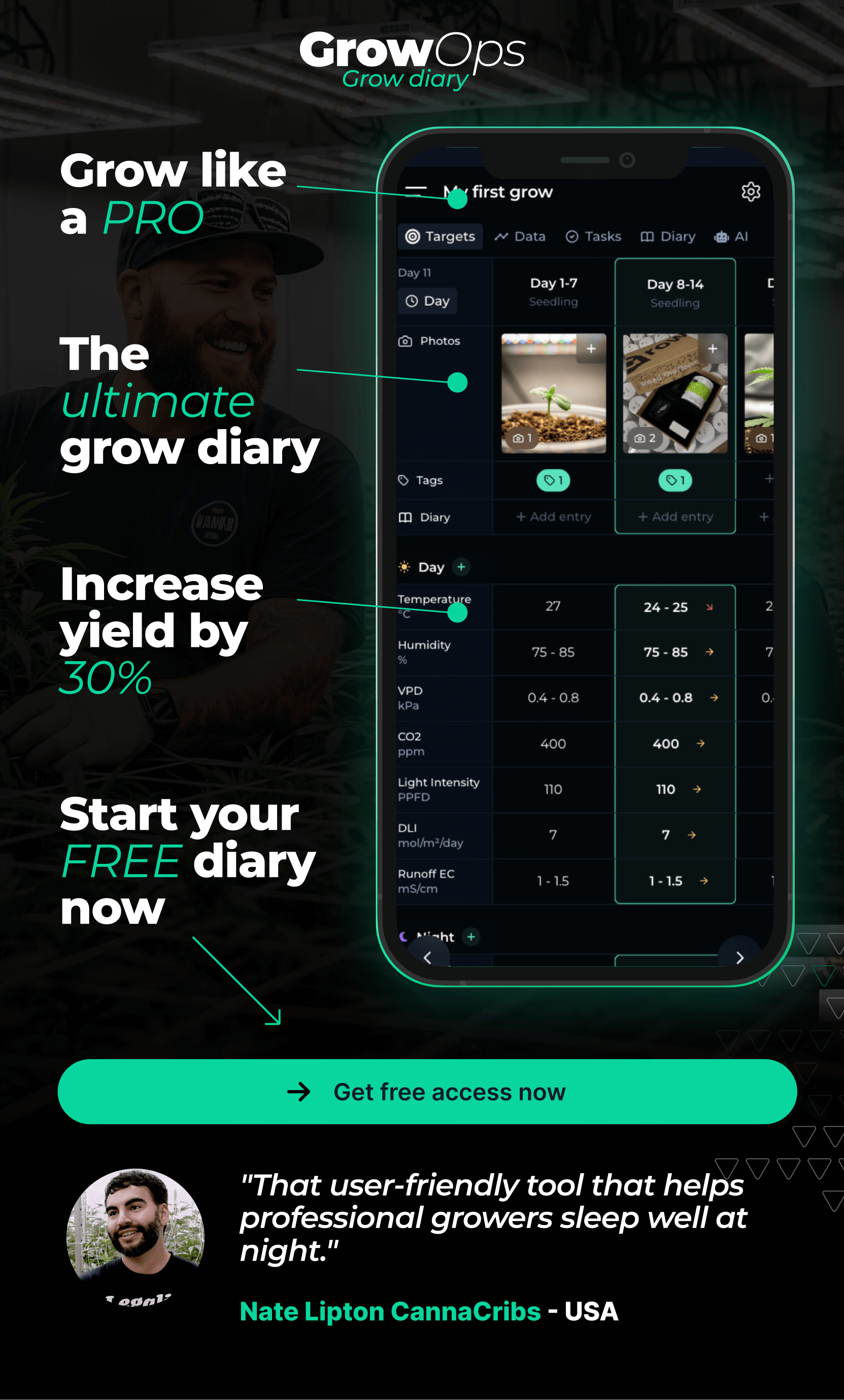CO2 in flowering stage. Why supplement when growing indoors.


Have you heard that supplementing CO2 in flowering stage can improve your yields?
When you love growing indoors, you can’t resist the calling to make improvements to your setup.
You’re always looking for that next thing that could elevate your grow and take your plant health and yields to the next level.
There’s a whole lot of confusing and conflicting information out there, and a lot of bro-science to boot!
But we’re here to help. 😀
We want to help growers get the most out of their indoor grow whilst growing greener.
Part of that is breaking things down simply and demystifying concepts – knowledge is power and we want to empower you to grow better!
Another big part of our purpose, is to provide you with ALL the tools you need to really fine tune your set up.
You can benefit from our Grow room sensor and App and a variety of FREE tools, so check out our…
Grow room sensor comparison chart.
Ultimate VPD environmental calendar.
Using these tools, you can avoid or solve any problems you encounter whilst growing, so you can grow better plants.
In this post, I’ll specifically be discussing:
– Why growers supplement with CO2 (carbon dioxide) when growing indoors.
– How CO2, light and temperature interact.
– The optimal amount of CO2 for each stage of growth.
– Why adding CO2 in flowering stage is the most important
– How much CO2 you should use.
Disclaimer: Any information given on this site is for educational purposes only. Please ensure if you’re growing cannabis you’re doing so in accordance with the law and subject to appropriate permissions and licenses of the applicable country.
Why supplement CO2 when growing indoors?
The amount of CO2 in your grow tent or grow room can be rapidly depleted by actively transpiring plants. So if you supplement CO2, you can boost plant growth and therefore yields.
Music to the ears of growers everywhere!
That’s right, you ‘CAN’ boost plant growth and yields… but this is by no means a certainty unless your indoor grow is already, otherwise finely tuned.
If your grow room is already well optimised, then supplementing your grow room with CO2 can make a big difference.
In fact, when your setup is already well honed, providing additional carbon dioxide can substantially improve your yields without you having to make any changes to how you grow. 😮
Especially if you add CO2 in flowering stage.
But you shouldn’t just supplement CO2 in flowering stage and hope to get amazing results, because:
Firstly, supplemental CO2 can also be helpful during vegetative growth – so don’t just take what you’ve heard and run with it, without further research and understanding.
Secondly, when you start tinkering around with enriching CO2, some interesting and fundamental changes take place that affect how your plants photosynthesise.
There are some very interesting interactions between CO2, light and temperature that you need to be aware of before diving into CO2 supplementation.

The CO2, light & temperature interaction.
Erik Runkle is professor at the Department of Horticulture at Michigan State University. He has a plethora of experience in lighting applications in indoor farms; energy conservation and crop production in controlled environments.
He produced a great article for greenhouse product news a few years back.
Whilst it’s greenhouse focussed, the principles still apply to your indoor cannabis grow. I’ll paraphrase it for you here.
Additional CO2 will not help you if your plants aren’t getting enough light.
But when there is a lot of, or surplus light, the provision of additional CO2 enables your plants to use more of that available light.
This speeds up the rate of photosynthesis.

Plants use more light for photosynthesis when exposed to higher concentrations of CO2.
The diagram above by Erik Runkle shows how plants can utilise more light for photosynthesis when levels of CO2 within the grow space are increased.
Faster photosynthesis means your plants can make more energy from the light they’re being provided which in turn means they can grow faster and produce greater yields.
The dotted lines show the points at which your plants experience light saturation at different levels of CO2.
Past those points adding any extra light doesn’t generate any further gains as the rate of photosynthesis levels out.
But, temperature plays an important factor too…

Photosynthesis increases alongside an increase in temperature and CO2.
The second diagram above shows that photosynthesis increases as temperature and levels of CO2 increase.
But also that here too, there is a maximum point, past which no further gains can be made by further increasing temperature and CO2.
In fact, here you can see that past a certain temperature, photosynthesis starts to take a dive.
So, the optimal temperature for photosynthesis varies depending on the concentration of CO2 in your grow room.
If there are low levels of CO2 in your grow space, the maximum rate of photosynthesis is reached sooner, at a lower temperature.
If you supplement your environment with additional CO2, the rate of photosynthesis increases much more substantially as temperatures increase.
This means when you supplement with CO2, you’re creating a higher or hotter optimal temperature for photosynthesis.
Because temperature and humidity are intertwined… The provision of surplus light, the additional CO2 to make use of it AND the higher temperatures to make use of that CO2, results in changes in VPD.
These vapour pressure deficit changes then also need to be managed.
Checkout our other VPD resources here:
5 ways VPD can improve your indoor grow.
What is the ideal temp and humidity for a grow tent?
What is the ideal grow room temp and humidity?
As always, there’s a fine balance to be struck. ⚖️

The optimal level of CO2 for different stages of growth.
Having addressed light intensity and temperature, the other thing to consider is what stage of growth your plants are in.
This is something overlooked when supplementing CO2. Often in favour of a more must be better (at anytime) approach.
There’s no benefit to supplementing your grow rooms with CO2 when your plants are young clones or seedlings.
The 400 ppm (parts per million) found in normal atmospheric conditions is sufficient for small plants.
Supplementing CO2 during vegetative growth.
Adding CO2 to your grow space when your plants are in vegetative growth (still assuming every other aspect of your grow space is optimised!) will speed up growth rates.
This enables you to grow bigger plants in less or the same amount of time.
And bigger, healthier plants tend to produce better, higher volume yields.
Supplementing CO2 in flowering stage.
Flowering is the most important time to add CO2 to your grow space. Specifically the first few weeks of flowering.
Which is why you’ve already heard mention of supplementing CO2 in flowering stage!
Adding CO2 during the early flowering stage in particular, can speed up growth, stimulate flower production and improve flower size.
Some newer growers are of the impression increased CO2 in flowering stage can increase the potency of their plants, but it won’t. The gains to be made are in the rates of growth.

Why adding CO2 in flowering stage is the most important
As mentioned above, providing your plants with an environment enriched with CO2 in flowering stage promotes faster growth.
Supplementing your grow space with CO2 can enable plants to grow approximately 30% faster.
The main reason professional growers choose to enrich their grow space with additional CO2, is because they have a limited grow area in which to grow as much product, as quickly and efficiently as possible.
When you grow professionally and have your optimisation and processes dialed in, supplementing CO2 could mean higher quantity and quality yields each cycle AND may also enable you to squeeze in an extra plant cycle during the year too.
This generates extra profitability whilst saving you money. You’re not having to extend your grow space and can have the opportunity to grow as much as if you had.
It’s only really worth adding CO2 if you really need the biggest possible crop in the shortest time.
Here are some of the benefits…
How CO2 benefits plants in flower:
– More CO2 increases the strength of the stems of your plants, which is important for supporting large, heavy trichrome covered flowers.
– More CO2 can facilitate faster photosynthesis as we’ve seen above. When photosynthesis speeds up, plants can create more leaves.
– This in turn means there are more leaves to photosynthesise, speeding the process up further and creating a positive feedback loop.
– Plants become more water efficient / drought tolerant which can be beneficial for growers.
– Plants can tolerate (and thrive at) higher temperatures.
Read more about the pros and cons of CO2 enrichment here in What’s the ideal grow room temp with CO2?
To get the most benefit from adding extra CO2 to your grow space, it’s important to collect grow data and analyse it. Look at the cost of supplementing CO2 vs the benefits.
It’s useful to see how much earlier your grow cycle was finished, or how much greater the yields were when you did use additional CO2 vs previous grows without CO2 supplementation.
You’ll only know if the extra CO2 was truly worth it and working well for you if you’re measuring as you go.
Likewise if you find that CO2 enrichment isn’t working for you, the data you collect along the way should help you work out what the problem is and how to fix it for next time.
We don’t advise providing additional CO2 in flowering stage if you’re not going to measure and track grow data and results.
On the least expensive end of the scale, you could use a CO2 meter to try to keep on top of your CO2 readings in your grow space. At the other end of the spectrum, you could use a CO2 controller.
But whatever your set up, it’s much simpler and more effective to use a grow room sensor.

Using a Grow room monitor to measure CO2 in your grow space.
A grow room sensor or monitor will consistently take readings and report back to you on what’s going on inside your grow space.
With a grow sensor, you can really learn about what happens in your grow room. What works and what doesn’t, and most importantly why.
Using a grow room monitor like ours, you’ll level up your knowledge whilst levelling up your grow. AND you’ll be able to reduce waste and do your bit for the environment too.
Take a look at our free grow room sensor comparison chart to see what other grow room sensors are out there that measure CO2.
Make an informed decision about the right tool for your grow setup.
One final point on CO2 in flower stage :
After the initial few weeks of flowering, CO2 levels can be reduced for a further few weeks.
And in the interest of not wasting resources, it’s worth noting that there’s no proof that additional CO2 has any benefits during late flower.
How much CO2 should you supplement?
It’s a good question, the answer to which is (as always) … that depends! 😉
As I’ve covered above, CO2, light intensity and temperature are all tightly intertwined.
This makes it difficult to know how to go about making changes that will benefit and not adversely affect your grow.
It’s hard, but don’t worry, we’ve got the solution for you.
In case you’ve not checked it out yet, we’ve created a truly comprehensive environmental calendar and timeline.
Once you’ve got access to your free copy, fill in all the relevant information about your specific grow and setup in the ‘Timeline settings’ section.
Then you’ll see that the environmental calculator itself adjusts to give you recommended temperature, humidity, VPD and leaf surface temperature values for both day and night, week by week, for the entirety of your grow cycle!
If you want to add CO2 in flowering stage, (or in vegetative stage too,) then make sure that you fill in the box in the timeline settings to say that you want to. Then the CO2 row within the calendar will pop up.
The CO2 level row then provides you with the level of CO2 you need to aim to maintain during each week of YOUR UNIQUE grow. (Assuming you’re providing enough light.)
You can find more information about supplementing CO2 here:
Grow better. Get a CO2 grow room calculator & grow calendar.

Takeaways:
CO2 enrichment yields the most benefits when you supply your plants with higher light levels, warmer temperatures and adequate water.
There’s no benefit to supplying your plants more CO2 than they can use, less is more.
The optimal level of CO2 is different for different stages of plant growth, but you’ll get the most benefit from supplementing CO2 in flowering stage.
When you start to tweak an environmental factor like CO2, it becomes very important to keep tabs on temperature, humidity, CO2 and light levels etc, because all of these factors are intertwined.
This is hard to do accurately if you aren’t using something like a grow room monitor or sensor.
Remember, not every grower needs to (or wants to) add CO2.
If you grow outside, or grow inside with plenty of space and no time restraints, there’s no need – and that’s ok!
However you choose to grow, my best advice is to lean on tools that make the growing process simpler for you so you can spend more time on and have more fun doing what you love. ✌️🌿










.avif)








